High-speed railway line reduces travel time between Beijing and Zhangjiangkou
Xinhua
1602150947000
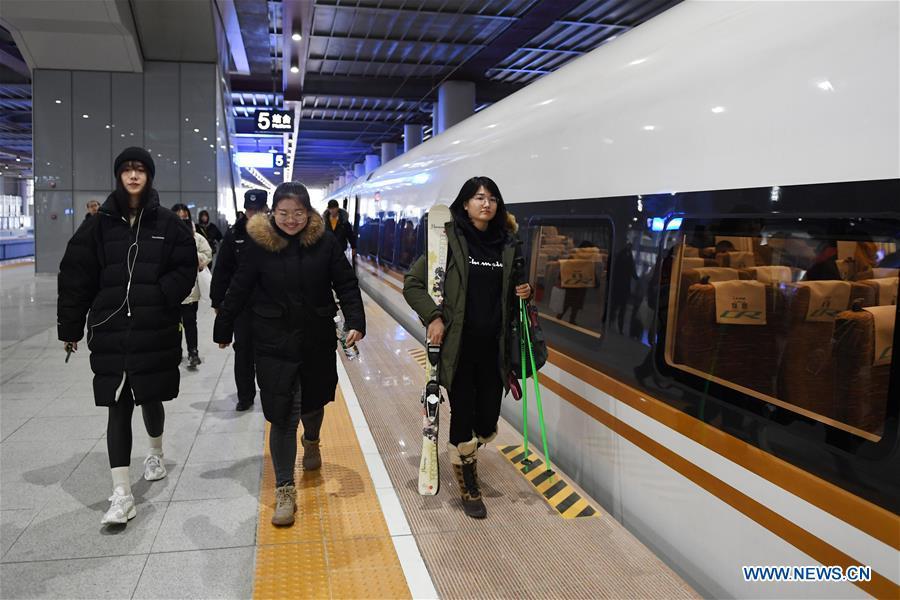
Xiao Zhen (R) holding ski boards and poles walks to take the high-speed train G8827 at Qinghe station in Beijing, capital of China, Jan. 11, 2020. With 5G signals, wireless charging and intelligent lighting, the high-speed railway line connecting Beijing and Zhangjiakou is a showcase of China's latest achievements in railway development from equipment manufacturing and new materials to new artificial intelligence technology. The train service, with a maximum design speed of 350 kph, reduces the travel time between Beijing and Zhangjiakou from over three hours to 47 minutes. (Xinhua/Ju Huanzong)
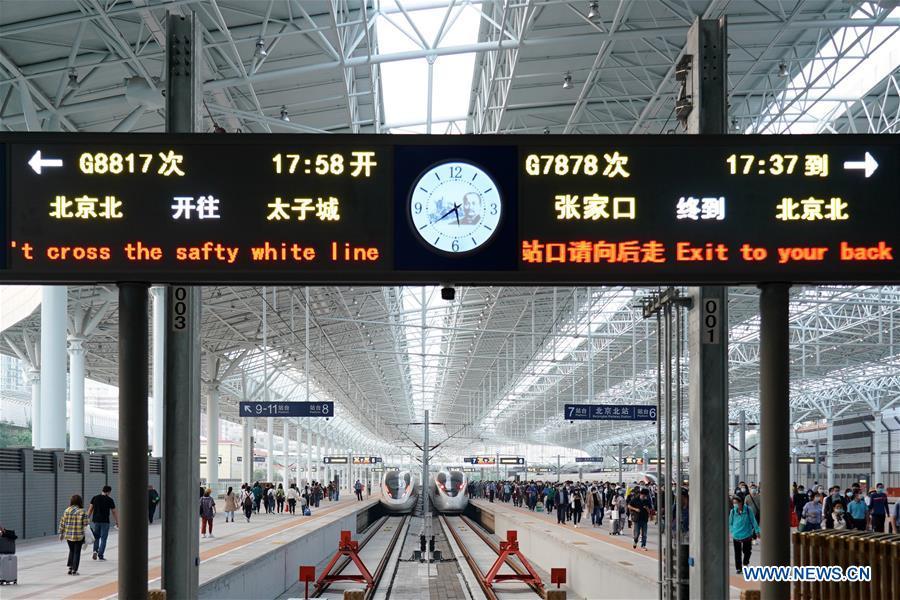
Passengers prepare to board trains of the Beijing-Zhangjiakou high-speed railway line in Beijing North Railway Station in Beijing, capital of China, Sept. 25, 2020. With 5G signals, wireless charging and intelligent lighting, the high-speed railway line connecting Beijing and Zhangjiakou is a showcase of China's latest achievements in railway development from equipment manufacturing and new materials to new artificial intelligence technology. The train service, with a maximum design speed of 350 kph, reduces the travel time between Beijing and Zhangjiakou from over three hours to 47 minutes. (Xinhua/Zhang Chenlin)
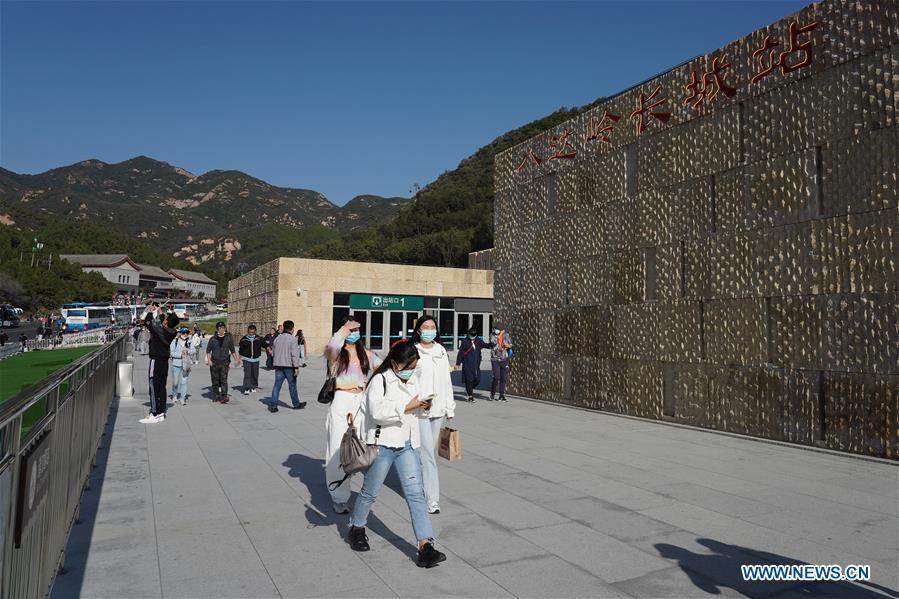
Tourists walk past Badaling Great Wall station of the Beijing-Zhangjiakou high-speed railway line in Beijing, capital of China, Oct. 6, 2020. With 5G signals, wireless charging and intelligent lighting, the high-speed railway line connecting Beijing and Zhangjiakou is a showcase of China's latest achievements in railway development from equipment manufacturing and new materials to new artificial intelligence technology. The train service, with a maximum design speed of 350 kph, reduces the travel time between Beijing and Zhangjiakou from over three hours to 47 minutes. (Xinhua/Ju Huanzong)
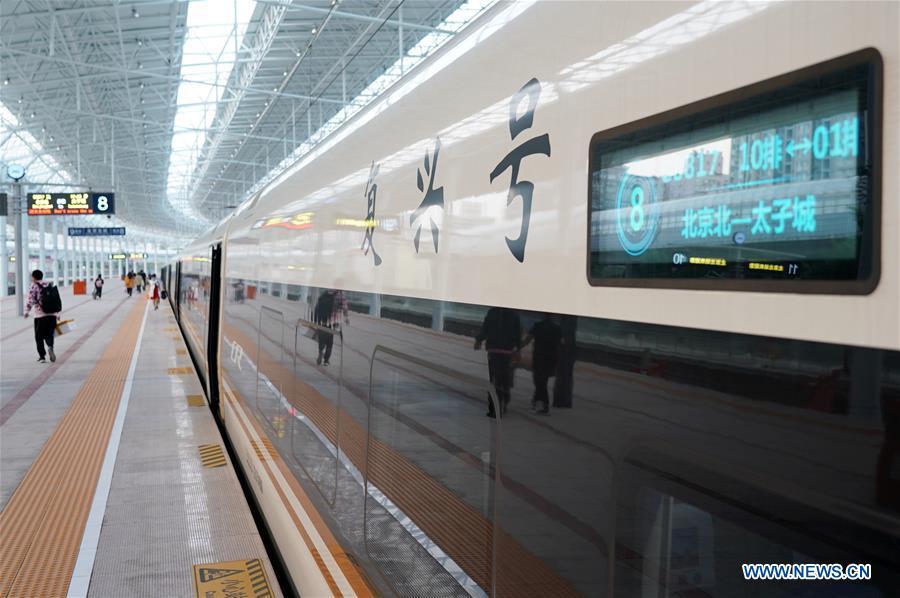
A train bound for Taizicheng station of the Beijing-Zhangjiakou high-speed railway line is seen in Beijing North Railway Station in Beijing, capital of China, Sept. 25, 2020. With 5G signals, wireless charging and intelligent lighting, the high-speed railway line connecting Beijing and Zhangjiakou is a showcase of China's latest achievements in railway development from equipment manufacturing and new materials to new artificial intelligence technology. The train service, with a maximum design speed of 350 kph, reduces the travel time between Beijing and Zhangjiakou from over three hours to 47 minutes. (Xinhua/Zhang Chenlin)

Passengers are seen on a train of the Beijing-Zhangjiakou high-speed railway line, Sept. 26, 2020. With 5G signals, wireless charging and intelligent lighting, the high-speed railway line connecting Beijing and Zhangjiakou is a showcase of China's latest achievements in railway development from equipment manufacturing and new materials to new artificial intelligence technology. The train service, with a maximum design speed of 350 kph, reduces the travel time between Beijing and Zhangjiakou from over three hours to 47 minutes. (Xinhua/Zhang Chenlin)

Passengers prepare to board trains of the Beijing-Zhangjiakou high-speed railway line in Beijing North Railway Station in Beijing, capital of China, Sept. 25, 2020. With 5G signals, wireless charging and intelligent lighting, the high-speed railway line connecting Beijing and Zhangjiakou is a showcase of China's latest achievements in railway development from equipment manufacturing and new materials to new artificial intelligence technology. The train service, with a maximum design speed of 350 kph, reduces the travel time between Beijing and Zhangjiakou from over three hours to 47 minutes. (Xinhua/Zhang Chenlin)
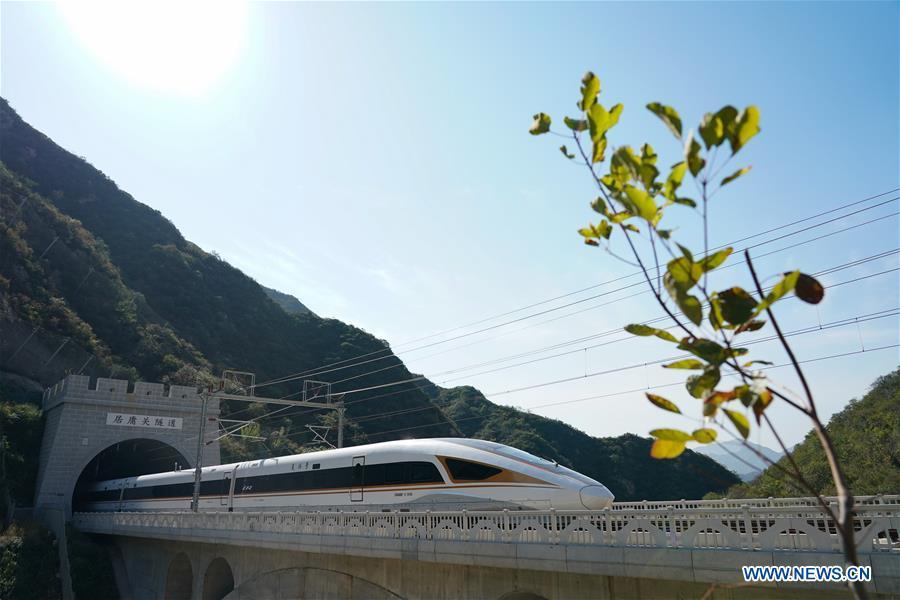
A high-speed train runs through the Juyongguan Pass tunnel of the Beijing-Zhangjiakou high-speed railway line in Beijing, capital of China, Oct. 6, 2020. With 5G signals, wireless charging and intelligent lighting, the high-speed railway line connecting Beijing and Zhangjiakou is a showcase of China's latest achievements in railway development from equipment manufacturing and new materials to new artificial intelligence technology. The train service, with a maximum design speed of 350 kph, reduces the travel time between Beijing and Zhangjiakou from over three hours to 47 minutes. (Xinhua/Ju Huanzong)
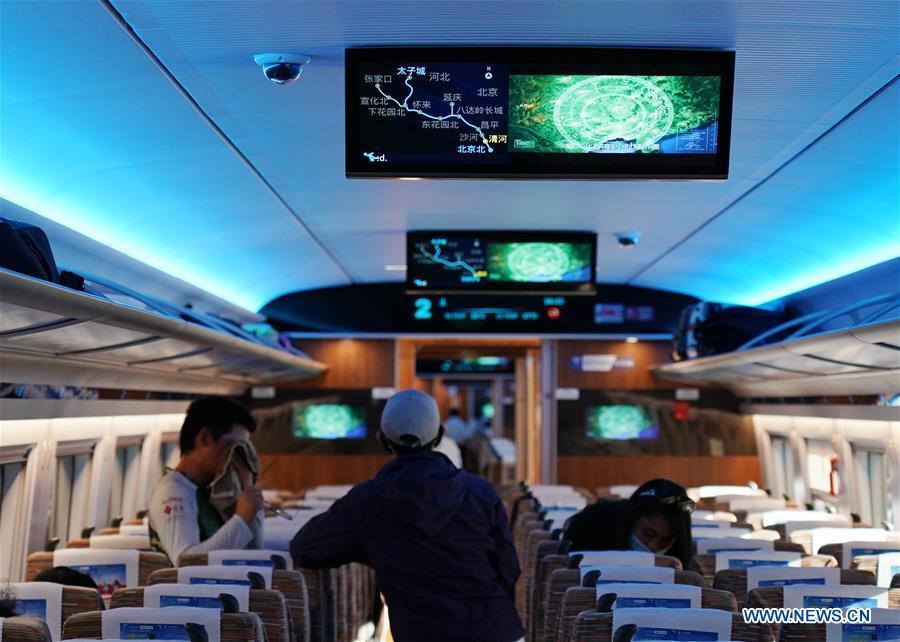
Passengers are seen on a train of the Beijing-Zhangjiakou high-speed railway line, Sept. 26, 2020. With 5G signals, wireless charging and intelligent lighting, the high-speed railway line connecting Beijing and Zhangjiakou is a showcase of China's latest achievements in railway development from equipment manufacturing and new materials to new artificial intelligence technology. The train service, with a maximum design speed of 350 kph, reduces the travel time between Beijing and Zhangjiakou from over three hours to 47 minutes. (Xinhua/Zhang Chenlin)

Ice and snow elements decoration is seen on a train of the Beijing-Zhangjiakou high-speed railway line, Sept. 26, 2020. With 5G signals, wireless charging and intelligent lighting, the high-speed railway line connecting Beijing and Zhangjiakou is a showcase of China's latest achievements in railway development from equipment manufacturing and new materials to new artificial intelligence technology. The train service, with a maximum design speed of 350 kph, reduces the travel time between Beijing and Zhangjiakou from over three hours to 47 minutes. (Xinhua/Zhang Chenlin)
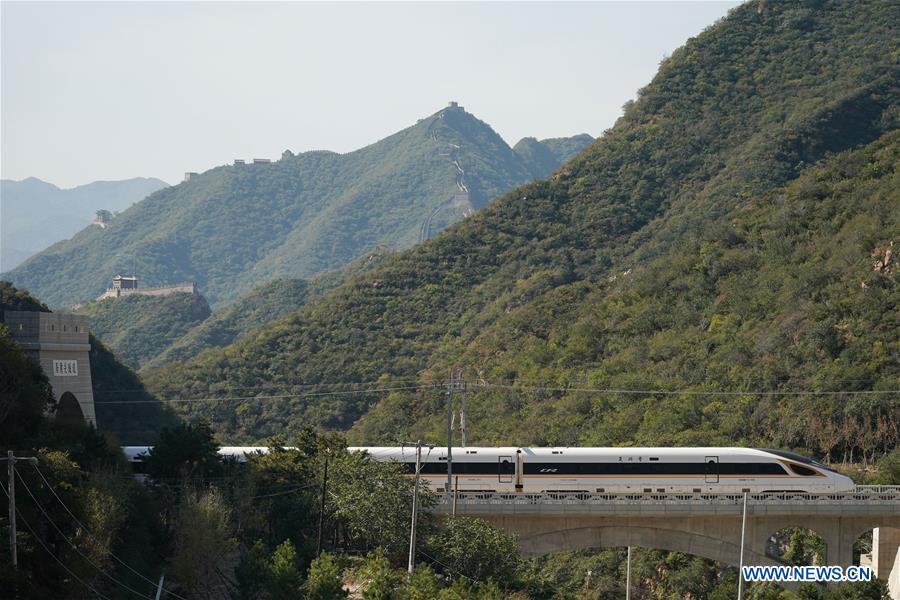
A high-speed train runs on the Juyongguan Pass section of the Beijing-Zhangjiakou high-speed railway line in Beijing, capital of China, Oct. 6, 2020. With 5G signals, wireless charging and intelligent lighting, the high-speed railway line connecting Beijing and Zhangjiakou is a showcase of China's latest achievements in railway development from equipment manufacturing and new materials to new artificial intelligence technology. The train service, with a maximum design speed of 350 kph, reduces the travel time between Beijing and Zhangjiakou from over three hours to 47 minutes. (Xinhua/Ju Huanzong)

Aerial photo taken on Sept. 26, 2020 shows Taizicheng station of the Beijing-Zhangjiakou high-speed railway line in Chongli district of Zhangjiakou city, north China's Hebei Province. With 5G signals, wireless charging and intelligent lighting, the high-speed railway line connecting Beijing and Zhangjiakou is a showcase of China's latest achievements in railway development from equipment manufacturing and new materials to new artificial intelligence technology. The train service, with a maximum design speed of 350 kph, reduces the travel time between Beijing and Zhangjiakou from over three hours to 47 minutes. (Xinhua/Zhang Chenlin)
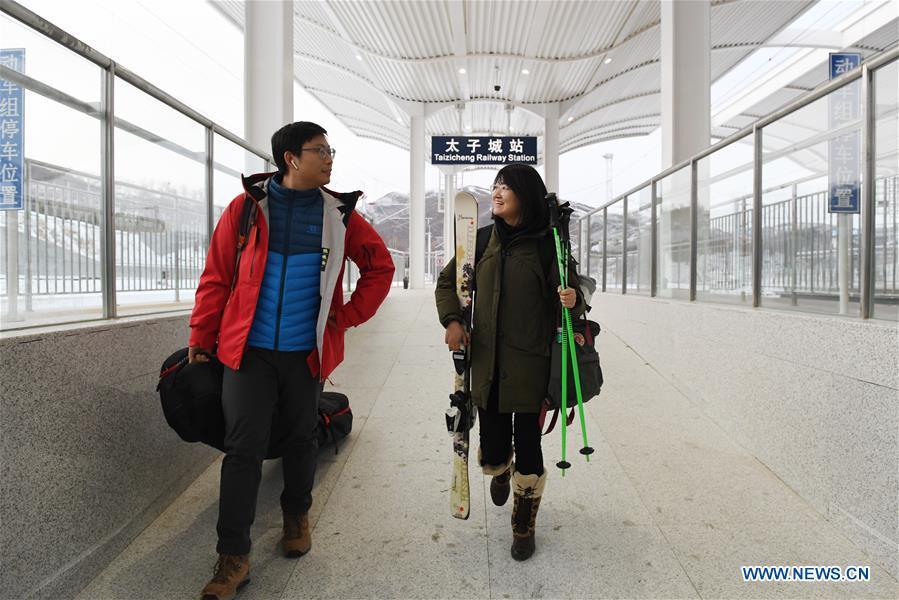
Xiao Zhen (R) holding ski boards and poles walks together with her friend upon arriving at Taizicheng station on Beijing-Zhangjiakou high-speed railway line in Chongli district of Zhangjiakou city, north China's Hebei Province, Jan. 11, 2020. With 5G signals, wireless charging and intelligent lighting, the high-speed railway line connecting Beijing and Zhangjiakou is a showcase of China's latest achievements in railway development from equipment manufacturing and new materials to new artificial intelligence technology. The train service, with a maximum design speed of 350 kph, reduces the travel time between Beijing and Zhangjiakou from over three hours to 47 minutes. (Xinhua/Ju Huanzong)
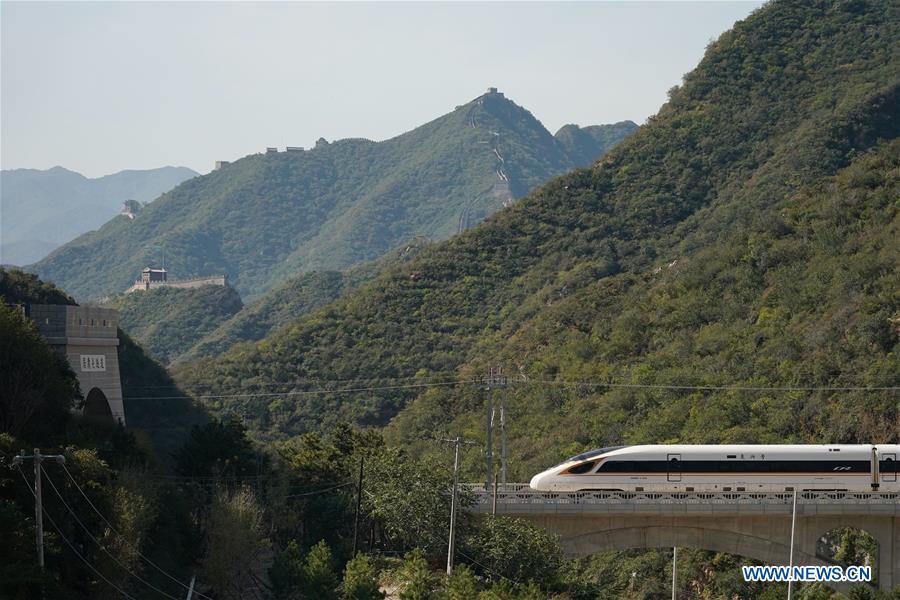
A high-speed train runs on the Juyongguan Pass section of the Beijing-Zhangjiakou high-speed railway line in Beijing, capital of China, Oct. 6, 2020. With 5G signals, wireless charging and intelligent lighting, the high-speed railway line connecting Beijing and Zhangjiakou is a showcase of China's latest achievements in railway development from equipment manufacturing and new materials to new artificial intelligence technology. The train service, with a maximum design speed of 350 kph, reduces the travel time between Beijing and Zhangjiakou from over three hours to 47 minutes. (Xinhua/Ju Huanzong)


